MARIANI’SVirtual
Gourmet
July 8, 2012
NEWSLETTER
"Tagliare" by Kate Greenaway
❖❖❖
THIS WEEK
THE WISCONSIN WAY
by Brian Freedman
NEW YORK CORNER
The Purple Fig
by John
Mariani
Notes from the Spirits Locker
In Tennessee, Don’t Call Their
Whiskey Bourbon
❖❖❖
by Brian Freedman

When
the opportunity to travel to Elkhart Lake, Wisconsin,
presented itself earlier this spring, the usual (and,
admittedly, stereotypical) images began dancing in my
mind. As a lifelong East Coaster, all of my
impressions of the mitten-shaped state were formed
either by the television or the grocery store. So when
the plane took off from Philadelphia International
Airport this past June, I settled into my seat, closed
my eyes, and allowed myself to be overtaken by images
of Laverne and Shirley on the bottling line; and grown
men with Styrofoam cheese wedges jammed onto their
heads, screaming for a Packers victory; and the dairy
section of my local supermarket.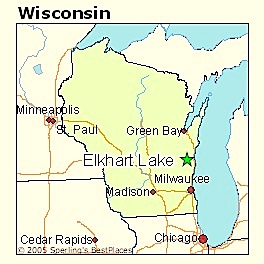
The reality, however, could not have been more
different. Put simply, Elkhart Lake charmed me from
the moment I arrived.
Located about an hour’s drive from Milwaukee in
Sheboygan County, Elkhart Lake is, in many ways, the
embodiment of a certain strain of Americana that’s
unfortunately been lost to the commercialism and
rampant consumerism of our times. This isn’t to imply,
however, that it’s a time capsule of a place,
stubbornly clinging to some sort of idealized past at
the expense of growing into the future. Far from it.
Rather, it has managed to strike an exquisite balance
between the sort of Midwestern charm you’d expect,
with a strain of excitement and sophistication you
might not.
The town itself, from an aesthetic standpoint,
is almost impossibly quaint, the houses tidy and
well-manicured, the streets perfect for leisurely
walks or old-fashioned drives. It’s that drivability,
in fact, that first put Elkhart Lake on the
international map: Between 1950 and 1952, a number of
open-road races were held here, bringing the village
to the attention of the moneyed Chicago sports-car
enthusiasts, and, eventually, to the world. (Markers
throughout the town note specific curves or other notable parts of
these original races.) Soon after, in 1955, Road America
(left)
opened its gates, and to this day continues to be one
of the top closed-circuit road race venues in the
country. The facility itself is beautiful, with
activities for visitors throughout the grounds,
excellent private facilities for corporate groups to
enjoy well-prepared meals while watching the cars
speed by, and a surprisingly deep history: Everyone
from Mario Andretti to Paul Newman raced here, and
many residents have stories about their encounters
with these legends.
other notable parts of
these original races.) Soon after, in 1955, Road America
(left)
opened its gates, and to this day continues to be one
of the top closed-circuit road race venues in the
country. The facility itself is beautiful, with
activities for visitors throughout the grounds,
excellent private facilities for corporate groups to
enjoy well-prepared meals while watching the cars
speed by, and a surprisingly deep history: Everyone
from Mario Andretti to Paul Newman raced here, and
many residents have stories about their encounters
with these legends.
For
the group I was there with, our Road America highlight
was a morning-long driving school at which we not only
learned how to handle a car more safely in adverse
conditions but also had the chance to put the
classroom lessons into practice, fishtailing Chevys
and VW’s in the parking lot, racing through a
mini-circuit of orange road-cones, and generally
getting to live the sort of
burnt-rubber-on-the-pavement fantasy I’ve had since I
was 14 years old.
For sports enthusiasts, in fact, there is no
shortage of entertainment. The Lake itself, a
breathtaking teal color, is used for a whole range of
water sports. And the loop around it is perfect for
runners.
It’s not all outdoor activities here, though,
and this, perhaps, is where I was most pleasantly
surprised. There are three resorts abutting the lake,
and each one offers a very different experience. My
personal advice is to avoid the Victorian Village
Resort, the most budget-friendly of the trio.
The accommodations run the gamut from unimpressive
studios to rather lovely multi-bedroom condos on the
water, but the overall level of experience is well
beneath that at the other two. Breakfast is functional
and joyless at best, with buffet eggs and meats, and
the serving pieces when I was there were all
disposable--even the coffee wasn’t served in a ceramic
mug. Dinner at the The
Back Porch Bistro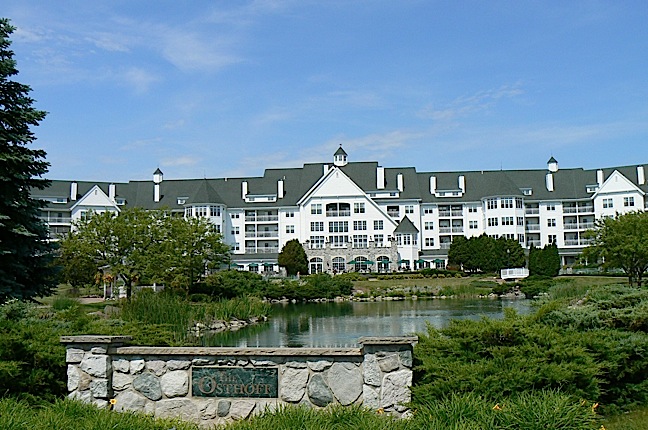 was better, but far from
memorable.
was better, but far from
memorable.
The Siebkens, however, a
historic property that has been in the same family
since 1916, is a sort of best-of-both-words place,
with a bygone-era drawing room replete with period
antiques, and possessing character and soulfulness to
spare. There are three buildings to choose from, each
offering its own unique and appealing charms, from the
antique to the more modern. It’s an excellent option
for couples and families alike.
And then there’s The Osthoff (right), a
resort that reminded me of nothing so much as a Four
Seasons on the lake. It’s an expansive property, and
both the indoor facilities and the grounds are
well-tended and relaxing. The Elk Room bar is a wonder
of soaring architectural grandeur that still conveys
warmth and boasts the sort of selection and pricing
that will stun serious wine drinkers. I don’t remember
the last time I saw the Orin Swift Veladora by the
glass (the pour is about the size of a bathtub), and
even Schramsberg vintage Blanc-de-Blancs was being
poured by the glass when I was there.
The Osthoff is overseen by General Manager Lola
Roeh, a passionate, ambitious professional who could
have been every bit as successful in major cities
across the country: Her understanding of and passion
for hospitality have clearly influenced the culture of
the place in its entirety, and every interaction here
is colored by the quiet confidence and
we’ll-do-anything-we-can-for-you ethos that sets great
properties apart from the rest.
Of particular note here is Aspira Spa (below), a
gorgeous destination facility whose range of
treatments is among the broadest I’ve seen anywhere,
whose staff is fabulously accomplished; and
L’École de la Maison, a cooking school located
in a kitchen that seems to be the embodiment of every
home chef’s fantasy, with gleaming pots and pans, and
every piece of equipment you could ever need. Chef
Instructor Scott Baker (he’s also the Food and
Beverage Manager at The Osthoff) is both talented and
infinitely patient, and his support staff is as
skilled as they  are
unprepossessing.
are
unprepossessing.
I also was
won over by the restaurants in Elkhart Lake. There are
plenty of excellent low-key options, here--the Off the
Rail Café is a gem, its sandwiches
well-conceived and deliciously executed--as well as
higher-end restaurants that would be successful
anywhere in the country.
The
Paddock Club, with its balance between
Midwestern dignity and urban chic (warm woods, exposed
brick), is a revelation. We visited on Tapas Tuesday,
which really means that Executive Chef Lynn Chisholm
visits the market that morning, buys whatever looks
good or otherwise inspiring, and writes an entirely
new menu that afternoon in time for dinner service.
Dishes like fried cheese curds (though a bit more
complicated that that sounds: they were beer-battered
and served with a dressing of smoked paprika
buttermilk) happily 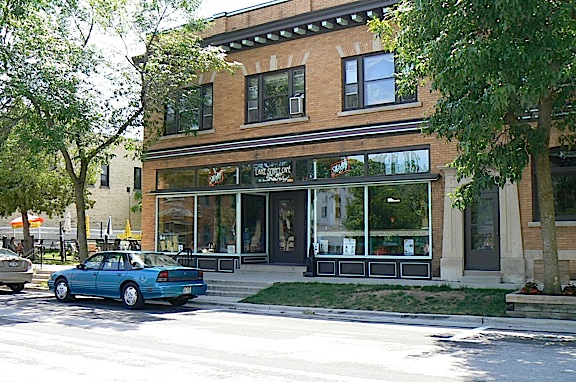 exist alongside more complex
ones. Oaxacan boar ribs were electrified by kohlrabi
and a vivid mango slaw; duck and foie gras agnolotti were
bathed in a deeply flavorful brodo with shiitakis and
scallions. Service was well informed, casual, and
professional, something we encountered at nearly every
meal.
exist alongside more complex
ones. Oaxacan boar ribs were electrified by kohlrabi
and a vivid mango slaw; duck and foie gras agnolotti were
bathed in a deeply flavorful brodo with shiitakis and
scallions. Service was well informed, casual, and
professional, something we encountered at nearly every
meal.
Lake Street
Café (right), with a mind-bogglingly
affordable list of legendary and more casual
wines--was just as wonderful, though perhaps less
expected. You enter through what is essentially a
pizzeria and bar and walk through until you come to
the dining room in the back. It’s a more traditional
space where quaint takes precedence over sleek in
design terms, but the food is very much a product of
our contemporary dining ethos. Lobster bisque managed
the difficult trick of being both concentrated and
perfectly seasoned. Foie gras Benedict, with its
pistachio polenta cake, foie vinaigrette, and scotch
quail egg, reminded me of a similarly irreverent (and
breakfast-inspired) preparation of this most haute (and,
these days, maligned) component that I tasted last
year at Animal, in Los Angeles. Just because Elkhart
Lake isn’t an urban
food mecca doesn’t mean it’s not plugged into the
important national food trends that are defining the
way we eat right now in America. Ambitious restaurants
are ambitious restaurants, no matter where they’re
located, and this one is a real standout.
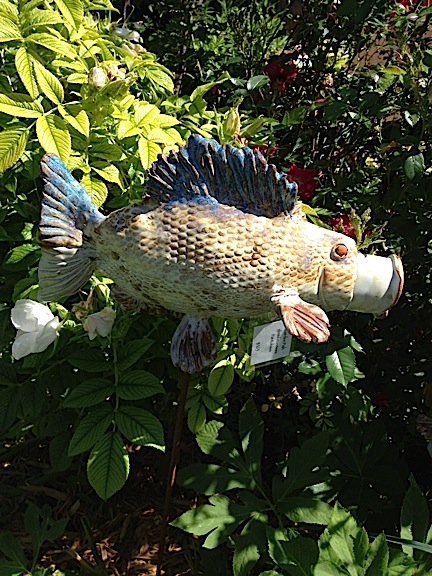 The Osthoff
itself boasts multiple lovely dining options, from Otto’s
(were the excellent breakfast is served) to Lola’s
on the Lake, where dishes that take full
advantage of the bounty of local and regional
ingredients are featured. Hazelnut crusted walleye was
kissed by the subtle sweetness of a maple beurre blanc;
grilled Berkshire pork chop, from nearby Golden Bear
Farms, was classically paired with accompaniments that
had been tweaked just enough to surprise. The apple
component here was incorporated in a roasted shallot
and potato-apple puree, and the richness of Port and
buttermilk blue cheese butter lent it all a heady
richness that paired gorgeously with the bottle of
Sturino Trotta “Jazz” 2006 we drank, a heady, complex
blend of cabernet sauvignon, zinfandel, merlot, petit
verdot, and cabernet franc.
The Osthoff
itself boasts multiple lovely dining options, from Otto’s
(were the excellent breakfast is served) to Lola’s
on the Lake, where dishes that take full
advantage of the bounty of local and regional
ingredients are featured. Hazelnut crusted walleye was
kissed by the subtle sweetness of a maple beurre blanc;
grilled Berkshire pork chop, from nearby Golden Bear
Farms, was classically paired with accompaniments that
had been tweaked just enough to surprise. The apple
component here was incorporated in a roasted shallot
and potato-apple puree, and the richness of Port and
buttermilk blue cheese butter lent it all a heady
richness that paired gorgeously with the bottle of
Sturino Trotta “Jazz” 2006 we drank, a heady, complex
blend of cabernet sauvignon, zinfandel, merlot, petit
verdot, and cabernet franc.
Wine, in
fact, is an important part of the Elkhart Lake
experience. Vintage, a wine shop in town that also
features craft beers, vinegar and olive oil, and a
roster of classes, is owned and overseen by Jaclyn
Stuart, a young California native who is widely
acknowledged as among the most exciting up-and-coming
wine professionals in the country, and is the
co-author of The
Complete Idiot’s Guide to Wine and Food Pairing. Nearly
all of the restaurants we visited had well-considered,
interesting lists that had been written with the menu
firmly in mind.
Sometimes, of course, you just
want a burger or a sandwich and a beer, and the
Stop-Inn Tavern & Restaurant, at the Siebkens, is
a great place for it, as well as for late-night drinks
and live music. Just make sure to save room for a
scoop or three at Sissy’s Coffee & Ice Cream
Shoppe afterward, where the high-butter-fat ice cream
reminded me of certain decadent scoops I’ve enjoyed in
Germany.
Elkhart Lake, then, is the kind of destination
that offers something for everyone, no matter what
your idea of a great get-away actually is. Pottery
classes at the Two Fish Gallery and Sculpture Garden (left) under the
tutelage of Patrick Robison (he co-owns it with his
wife Karen; tours (and overeating, especially the
stupendously squeaky cheese curds and the
near-ambrosial 7-year-old sharp cheddar) at the
Hening’s Cheese Factory; spa treatments--it’s all
here, in a place where, I have to admit, I least
expected it.
Sometimes, the best travel experiences are the
ones that sneak up on you. I will definitely be back,
next time with my family in tow.
❖❖❖
NEW
YORK CORNER
by
John Mariani
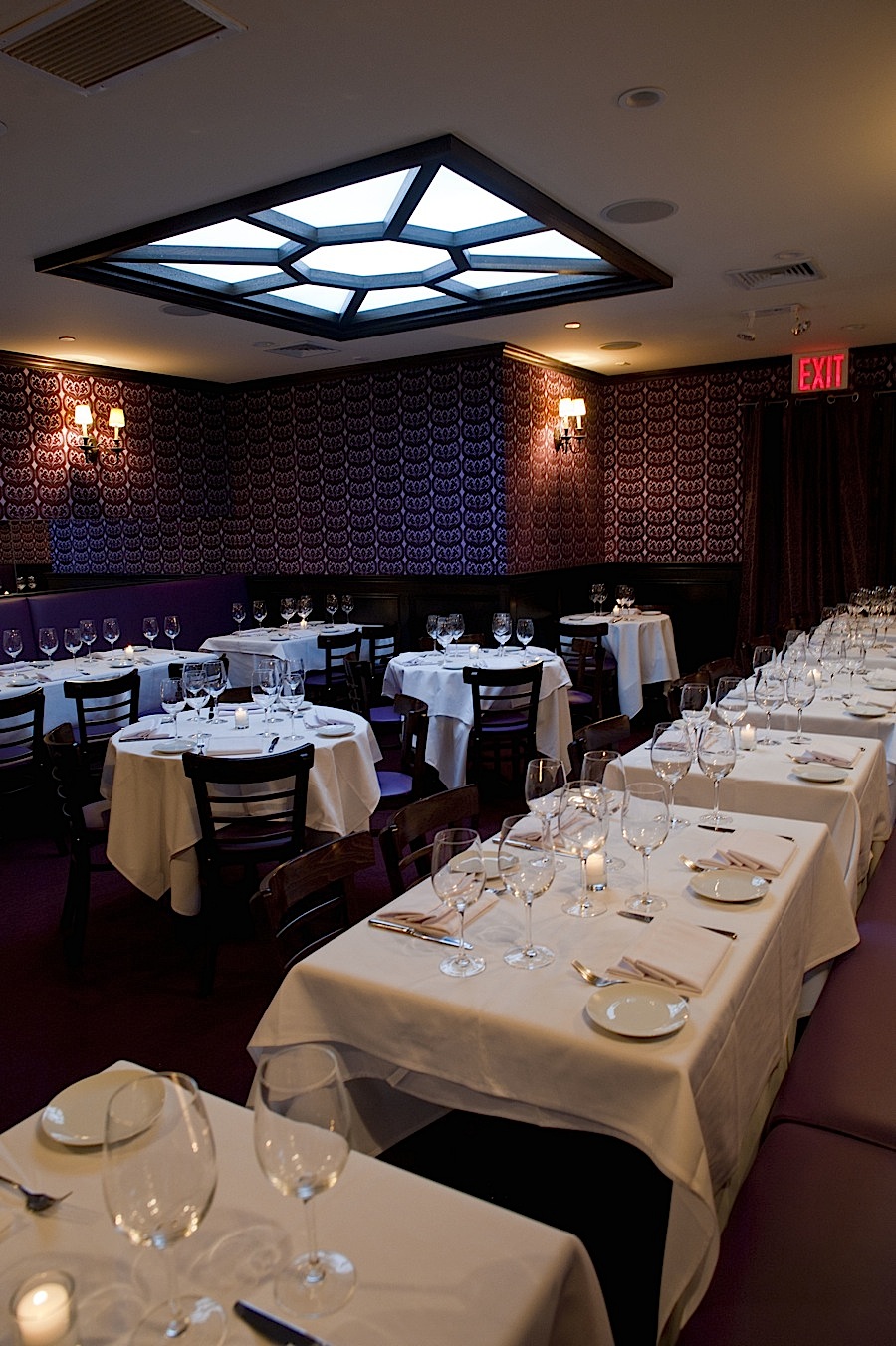 You might easily
pass by The Purple Fig bistro on West 72nd Street. For
one thing it’s a few steps below street level with an
entrance door that looks like it hides a speakeasy.
Inside there’s a small bar up front and to the rear
the equally small dining room (left) whose
skylight blunts the feeling of being quite so
subterranean. Once seated the congenial staff will
make you feel quite comfortable, and it is a matter of
your taste if the William Morris-like wallpaper is
cozy or a tad too dark.
You might easily
pass by The Purple Fig bistro on West 72nd Street. For
one thing it’s a few steps below street level with an
entrance door that looks like it hides a speakeasy.
Inside there’s a small bar up front and to the rear
the equally small dining room (left) whose
skylight blunts the feeling of being quite so
subterranean. Once seated the congenial staff will
make you feel quite comfortable, and it is a matter of
your taste if the William Morris-like wallpaper is
cozy or a tad too dark.
The real brightness at The Purple
Fig is in Chef-owner Conrad Gallagher’s vibrant
cooking, with his own ebullient Irish personality writ
large. Gallagher has been cooking on various
continents for a long time now, and I first tasted his
food in Dublin a decade ago, when he ran Peacock
Alley, bringing a lot more style to Irish cooking than
most anyone around him. He also now runs a restaurant
in Las Vegas, to which he commutes weekly, so, given
the small size of his kitchen and crew here in NYC,
you might want to call ahead to see if Gallagher’s
back there cooking.
For good reason, eggs seem to be
getting more attention on dinner menus these days, and
Gallagher's deep-fried soft duck egg with polenta,
blood pudding, frisée salad with prosciutto and
lemon oil makes a good case for the idea--wonderful
flavors and textures in fine balance. He also does a
tender risotto with asparagus, roasted chanterelles
and slow-braised duck leg with a mushroom foam that is
another study in getting contrasting textures and
woodsy, meaty, salty flavors just right. Of
course, Gallagher uses wild salmon, which makes all the
difference in the world (I won't touch the
muddy-tasting farm-raised variety), which 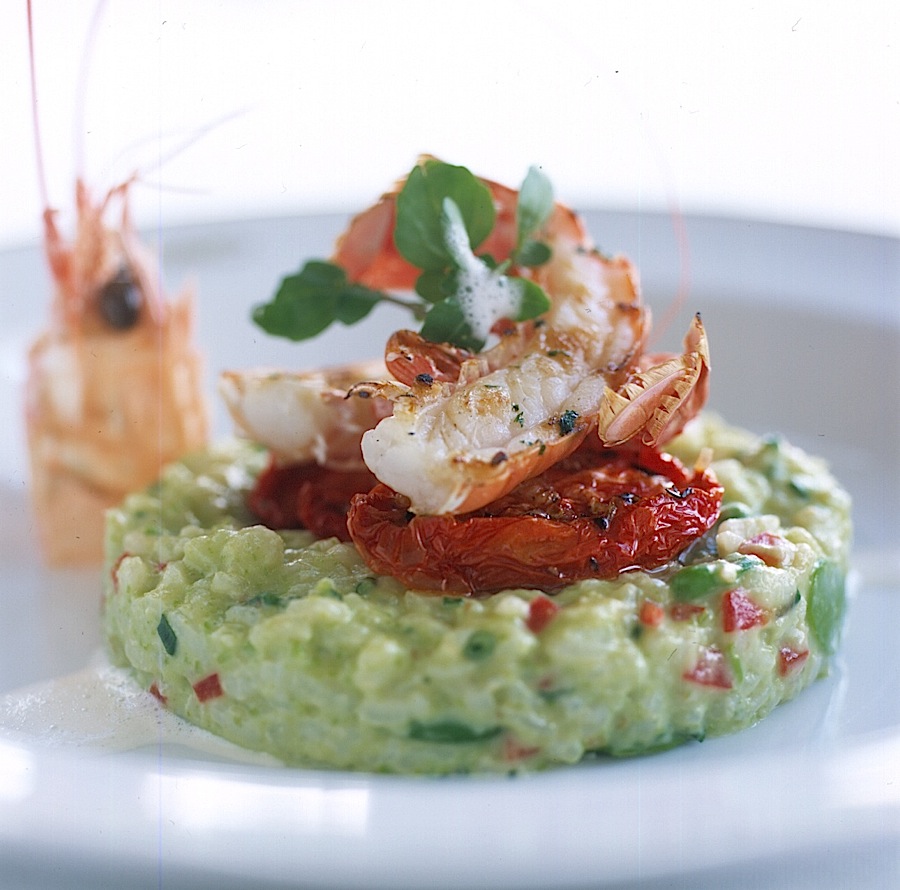 he makes into
a pastrami with Dijon mustard and dill, pickled pear
and ginger with cucumber, a dash of wasabi
crème fraîche and a touch of soy.
Creamy, smooth and luscious describes his goose liver
parfait with a sweet fig marmalade on toasted brioche
with a spinach salad, apricot compote and hazelnut
aïoli, which just tipped over into being too much
on one plate.
he makes into
a pastrami with Dijon mustard and dill, pickled pear
and ginger with cucumber, a dash of wasabi
crème fraîche and a touch of soy.
Creamy, smooth and luscious describes his goose liver
parfait with a sweet fig marmalade on toasted brioche
with a spinach salad, apricot compote and hazelnut
aïoli, which just tipped over into being too much
on one plate.
For entrees, I loved the peppered
filet of beef with goat's cheese ravioli, a celeriac
fondant, watercress cream, and oxtail jus, and if you
love chicken more than anything, you'll be ecstatic
over the way he serves it so juicy, with a mushroom
duxelle, cèpe-flavored orzo pasta, with
asparagus, peas, and favas in a Spanish albufera sauce.
Excellent Muscovy duck breast is
roasted rare, but not bloody, and comes with poached
figs, butternut puree, puy lentils,
sunny-side-up quail eggs, and green apple salad.
Pan-roasted swordfish that night had a faintly fishy
smell to it, served with truffled crushed potatoes,
braised baby leeks, a fricassée of enoki
mushrooms and summer morels. So, too, roasted
scallops had a strong taste, married to foie gras,
celeriac rémoulade and mousseline, rocket,
shaved black truffles (not much flavor to them), and a
truffled aïoli.
 The winelist at The Purple
Fig is priced to sell, with plenty of bottlings under
$50.
The winelist at The Purple
Fig is priced to sell, with plenty of bottlings under
$50.
All the desserts I ate were very good
indeed, ranging from an espresso-flavored crème
brûlée made with a rich duck egg, with
raspberries and a shortbread biscuit, to a finely
grained mango and cilantro cheesecake with a spark of
chili syrup and mango and coriander ice cream.
There's obviously a lot going on
with these dishes, and I wouldn't mind at all if
Gallagher deleted one or two ingredients or side items
from most plates, if only to lessen the burden on the
kitchen to keep everything at its peak of
freshness. But in the flavors of everything,
never disparate and always delectable, there is a
wonderful imagination at work here. Conrad
Gallagher is nothing if not ambitious, and that is
built on many many years of crafting his own personal
identity on his cooking. Anyone living or
shopping or going to Lincoln Center on the West Side
deserves to make The Purple Fig a regular stop; for
everyone else, it makes the case that the neighborhood
continues to burgeon with a wide array of exciting new
restaurants.
The Purple Fig is
open lunch and dinner daily. Dinner appetizers
run $8.95-$14.95, main courses $23.95-$36.95.
❖❖❖
In
Tennessee, Don’t Call Their Whiskey Bourbon
by
John Mariani
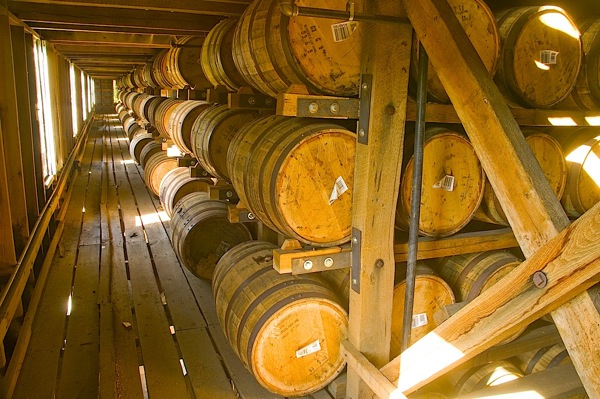 If
you should swagger
into a bar in Nashville and, like Anne Christie, bark,
“Gimme a whiskey—ginger ale on the side,” you’re
probably going to get Jack Daniel’s or George Dickel.
And if you sip it and say, “Damn fine bourbon,” you
may get thrown out.
If
you should swagger
into a bar in Nashville and, like Anne Christie, bark,
“Gimme a whiskey—ginger ale on the side,” you’re
probably going to get Jack Daniel’s or George Dickel.
And if you sip it and say, “Damn fine bourbon,” you
may get thrown out.
Tennesseans
take a justifiable pride in their namesake whiskey,
which, they will remind you, is not bourbon, which is
mostly made in Kentucky. NAFTA (the North American
Free Trade Agreement) defines Tennessee whiskey as
nothing more than a “straight bourbon whiskey produced
in the state of Tennessee.” But you won’t find the
word bourbon anywhere on the labels of the four
distilleries that make Tennessee Whiskey--Jack
Daniel’s, George Dickel, Prichard’s, and Collier &
McKeel (this last sold only in the state of
Tennessee). By legal definition, the distinction may
seem slight: bourbon must be distilled from a mash of
51 percent corn, then aged in charred oak barrels for
a minimum of two years; Tennessee whiskeys are made
much the same way but not necessarily aged in charred
oak. But both Jack Daniel’s and Dickel are also
filtered through sugar-maple charcoal before
aging--called the Lincoln County process--which is
said to impart a smooth sweetness to the liquor.
Of course,
nothing’s ever that simple. “When it comes out of the
still, it’s Tennessee whiskey if it’s made in
Tennessee,” says Phil Prichard of Prichard’s
Distillery in Kelso, TN, part of Lincoln County. “We
do not use the Lincoln Process because I think it
filters out a lot of things like fusel oils and
congeners that make for different flavors.”
Prichard also makes a single malt whiskey, a 95
proof “Double Barreled Bourbon, a Sweet Lucy Bourbon
Liqueur, and a 90 proof Lincoln County Lightning, made
from white corn straight out of the still, that is,
moonshine. To him they are all Tennessee whiskeys. 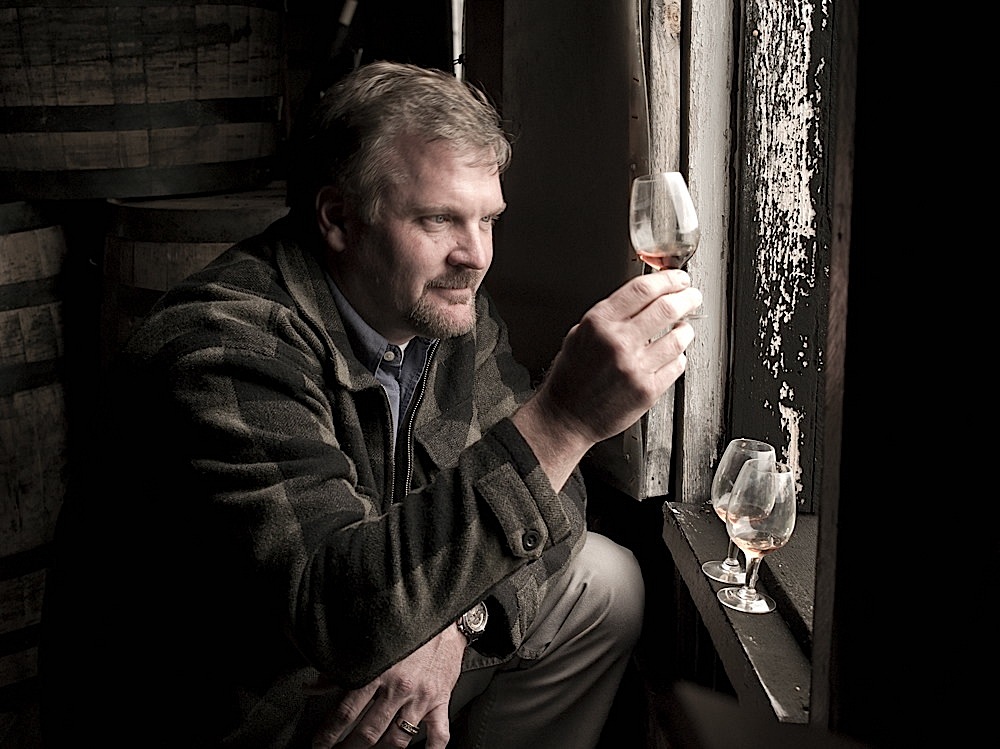
Jack Daniel’s--whose fans just call it “Jack”
of “JD”-is by far the largest and best known producer.
They mellow the spirit by filtering through 10 feet of
hard sugar maple charcoal. For many years Jack
Daniel’s Old No. 7 Black Label (80 proof), dating to
the 1830’s and winner of a gold medal at the 1904 St.
Louis World’ Fair, was their only product. In the past
couple of decades, though, the brand has expanded to
produce Gentleman Jack Rare (80 proof), which appeared
in 1988, Jack Daniel’s Single Barrel (94 proof) in
1997, and Jack Daniel’s Tennessee Honey (70 proof) in
2011. (They also make a much cheaper, lighter, less
aged 80 proof green label they don’t even show on
their website.)
I did a tasting of various
Tennessee whiskeys in a most appropriate place, the
historic Oak Bar at the Hermitage Hotel in Nashville,
TN, with a Hunter’s Plate of smoked and pickled
charcuterie by Chef Tyler Brown.
Given
the similarities between Kentucky bourbons and
Tennessee whiskeys, I cannot claim to taste
significant distinctions. What I can do is tell you
how they taste, from bottle to bottle.
Jack Daniel’s Old No. 7,
with its familiar black label, has a fine balance of
charred oak and caramel flavors and hits the back of
the tongue like a love tap, just enough to linger. (By
the way, no one knows what the number seven signifies
on the label.)
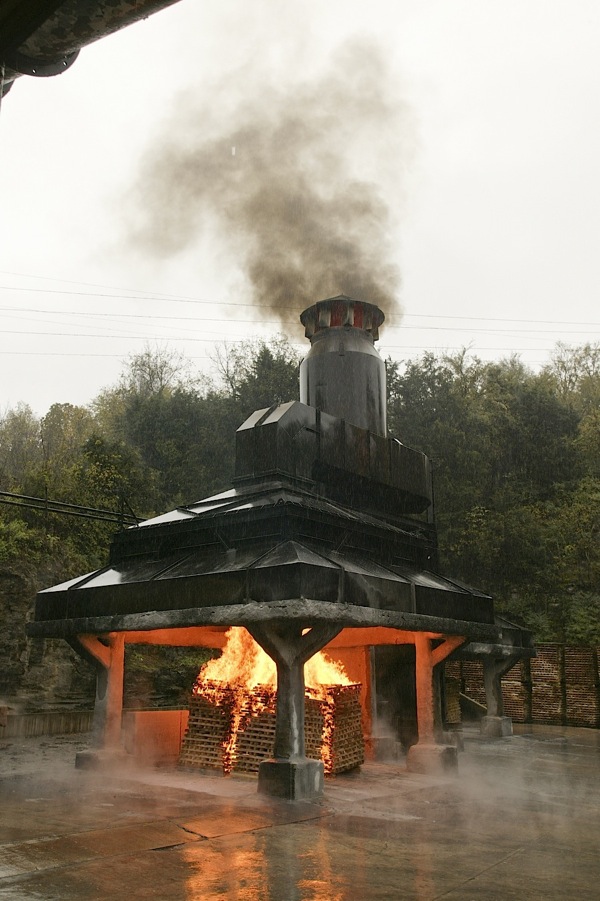 Gentleman Jack is
charcoal mellowed twice, once before and once after
aging—they call it the “blessing”--which makes it
somewhat mellower, a little sweeter and a bit gentler
on the finish.
Gentleman Jack is
charcoal mellowed twice, once before and once after
aging—they call it the “blessing”--which makes it
somewhat mellower, a little sweeter and a bit gentler
on the finish.
Jack Daniel’s Single
Barrel is a powerhouse at 94 proof, drawn
from barrels that rest in the warmer, upper floors of
the distillery by Master Distiller Jeff Arnett, who
contends each barrel can have different nuances that
make one bottle slightly different from the next. It’s
a darker whiskey, robust but very satisfying and warm
on the palate.
Jack Daniel’s Tennessee
Honey is, really, a novelty, with an added
honey liqueur, which the producer recommends be served
“chilled straight or in drinks with other mixers like
lemonade, tea or ginger ale.” That works for me,
especially during the summer, and it makes a splendid
Old Fashioned, with a dash of bitters.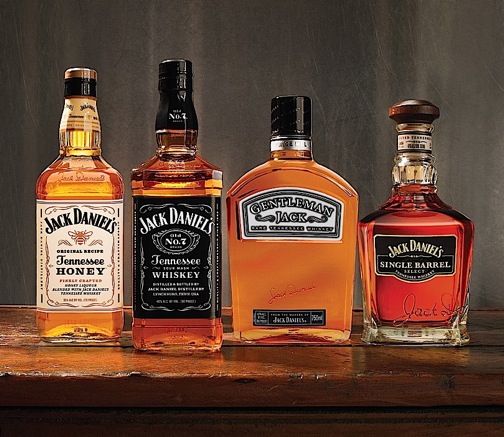
"Rick burning," which gives the
oak wood staves a good char.
The
story goes that George
A. Dickel, who founded his distillery in
Tullahoma, TN, in 1870, discovered
that whisky made during the winter was smoother than
whisky made in the summer. So, he began chilling his
distillation before it went into the charcoal vats.
(He also called it “Whisky,” as they do in Scotland.)
Closed for 40 years, the distillery re-opened in 1958,
now run by Master Distiller John Lunn, who makes No. 8
and No. 12 labels (as well as Cascade Hollow and
Barrel Select, which I have not tasted).
If there were such a thing as a “classic”
Tennessee Whiskey, No. 8 might be it: vanilla, toast,
corn, and smoke all mingle in the bottle, with a
lively burn at the back of it all. No. 12 is a deeper,
richer, more concentrated spirit, at 90 proof, blended
from older whiskeys than the No. 8. This you do not
knock back at a bar; you sip it after dinner.
The
renegade Prichard’s
Tennessee Whiskey, founded in 1997 in an old
schoolhouse complete with basketball hoops, is made
from white corn in small batch copper pots, then aged
in white oak barrels.
The nose is a glorious burst of vanilla and
soft oak, it begins sweet on the tongue, then trails
off with an engaging, peppery finish that stays there
until you take your next sip. Which you
will.
John Mariani's wine column appears in Bloomberg Muse News, from which this story was adapted. Bloomberg News covers Culture from art, books, and theater to wine, travel, and food on a daily basis.
❖❖❖
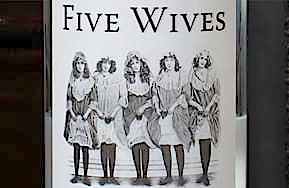 MITT ROMNEY
SAYS,"WHAT'S GOOD FOR UTAH IS
MITT ROMNEY
SAYS,"WHAT'S GOOD FOR UTAH ISBAD FOR IDAHO . . . OH, WAIT, MAYBE IT'S
THE OTHER WAY AROUND?"
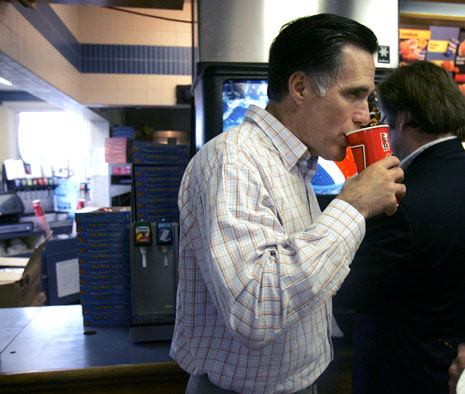
Ogden’s
Own Distillery’s Five Wives Vodka has been
banned by the Idaho State Liquor Division. “We feel
Five Wives Vodka concept is offensive to a prominent
segment of our population and will not be carried,” said Howard
Wasserstein, deputy director of the Liquor Division.
In response Steve Conlin, partner at Ogden’s Own
Distillery in Utah, said, “We have a product
that has sold nearly 1,000 cases in six months in
Utah. If the reaction is because of a religious
concern, we think they are extremely misguided. We can
only presume he means Mormons, though that makes
little sense as they allow Polygamy Porter from
Wasatch Beers of Utah to be sold. We’re a little
dumbfounded by it all.”
 TRAVEL
ARTICLES WE NEVER FINISHED READING
TRAVEL
ARTICLES WE NEVER FINISHED READING
“On a sweltering afternoon recently
I stood in a dusty skateboard park in Stratford,
Ontario, surrounded by about a dozen sullen-looking
boys, all around 17. I mentioned someone they might
know, someone who a few years ago used to hang out
there, too, and a couple of them said he was a jerk.
They could have been jealous, of course: We were
discussing Justin
Bieber, who not long ago was a local
kid busking
on the street a few blocks from this
park and is now a pop star estimated by Forbes magazine
to have earned $55 million, even before last week’s
release of his third full-length album, `Believe.’”—Steve McElroy, “Tracking
the Bieb and the Bard in Stratford,” NY Times
(6/24/12).
Any of John Mariani's
books below may be ordered from amazon.com.
 |
My latest book, which just won the prize for best book from International Gourmand, written with Jim Heimann and Steven Heller, Menu Design in America, 1850-1985 (Taschen Books), has just appeared, with nearly 1,000 beautiful, historic, hilarious, sometimes shocking menus dating back to before the Civil War and going through the Gilded Age, the Jazz Age, the Depression, the nightclub era of the 1930s and 1940s, the Space Age era, and the age when menus were a form of advertising in innovative explosions of color and modern design. The book is a chronicle of changing tastes and mores and says as much about America as about its food and drink.
“Luxuriating vicariously in the pleasures of this book. . . you can’t help but become hungry. . .for the food of course, but also for something more: the bygone days of our country’s splendidly rich and complex past. Epicureans of both good food and artful design will do well to make it their coffee table’s main course.”—Chip Kidd, Wall Street Journal.
“[The menus] reflect the amazing craftsmanship that many restaurants applied to their bills of fare, and suggest that today’s restaurateurs could learn a lot from their predecessors.”—Rebecca Marx, The Village Voice. |
"Eating Italian will never be the same after reading John Mariani's entertaining and savory gastronomical history of the cuisine of Italy and how it won over appetites worldwide. . . . This book is such a tasteful narrative that it will literally make you hungry for Italian food and arouse your appetite for gastronomical history."--Don Oldenburg, USA Today. "Italian
restaurants--some good, some glitzy--far
outnumber their French rivals. Many of
these establishments are zestfully described
in How Italian Food Conquered the World, an
entertaining and fact-filled chronicle by
food-and-wine correspondent John F.
Mariani."--Aram Bakshian Jr., Wall Street
Journal.
"Equal parts
history, sociology, gastronomy, and just
plain fun, How Italian Food Conquered the
World tells the captivating and delicious
story of the (let's face it) everybody's
favorite cuisine with clarity, verve and
more than one surprise."--Colman Andrews,
editorial director of The Daily
Meal.com. "A fantastic and fascinating
read, covering everything from the influence
of Venice's spice trade to the impact of
Italian immigrants in America and the
evolution of alta cucina. This book will
serve as a terrific resource to anyone
interested in the real story of Italian
food."--Mary Ann Esposito, host of PBS-TV's
Ciao
Italia. "John Mariani has written the
definitive history of how Italians won their
way into our hearts, minds, and
stomachs. It's a story of pleasure over
pomp and taste over technique."--Danny Meyer,
owner of NYC restaurants Union Square Cafe,
Gotham Bar & Grill, The Modern, and
Maialino.
|
 |
 |
 |
 |
 |
 |
 |
 |
❖❖❖
 Everett Potter's Travel Report:
Everett Potter's Travel Report: 
 Eating Las Vegas
is the new on-line site for Virtual Gourmet
contributor John A. Curtas., who since 1995
has been commenting on the Las Vegas food
scene and reviewing restaurants for Nevada
Public Radio. He is also the
restaurant critic for KLAS TV, Channel 8 in
Las Vegas, and his past reviews can be
accessed at KNPR.org.
Click on the logo below to go directly to
his site.
Eating Las Vegas
is the new on-line site for Virtual Gourmet
contributor John A. Curtas., who since 1995
has been commenting on the Las Vegas food
scene and reviewing restaurants for Nevada
Public Radio. He is also the
restaurant critic for KLAS TV, Channel 8 in
Las Vegas, and his past reviews can be
accessed at KNPR.org.
Click on the logo below to go directly to
his site.

Tennis Resorts Online: A Critical Guide to the World's Best Tennis Resorts and Tennis Camps, published by ROGER COX, who has spent more than two decades writing about tennis travel, including a 17-year stretch for Tennis magazine. He has also written for Arthur Frommer's Budget Travel, New York Magazine, Travel & Leisure, Esquire, Money, USTA Magazine, Men's Journal, and The Robb Report. He has authored two books-The World's Best Tennis Vacations (Stephen Greene Press/Viking Penguin, 1990) and The Best Places to Stay in the Rockies (Houghton Mifflin, 1992 & 1994), and the Melbourne (Australia) chapter to the Wall Street Journal Business Guide to Cities of the Pacific Rim (Fodor's Travel Guides, 1991).


MARIANI'S VIRTUAL GOURMET
NEWSLETTER is published weekly. Editor/Publisher: John
Mariani.
Contributing Writers: Christopher Mariani, Robert Mariani,
John A. Curtas, Edward Brivio, Mort Hochstein,
Suzanne Wright, and Brian Freedman. Contributing
Photographers: Galina Stepanoff-Dargery,
Bobby Pirillo. Technical Advisor: Gerry McLoughlin.
© copyright John Mariani 2012
